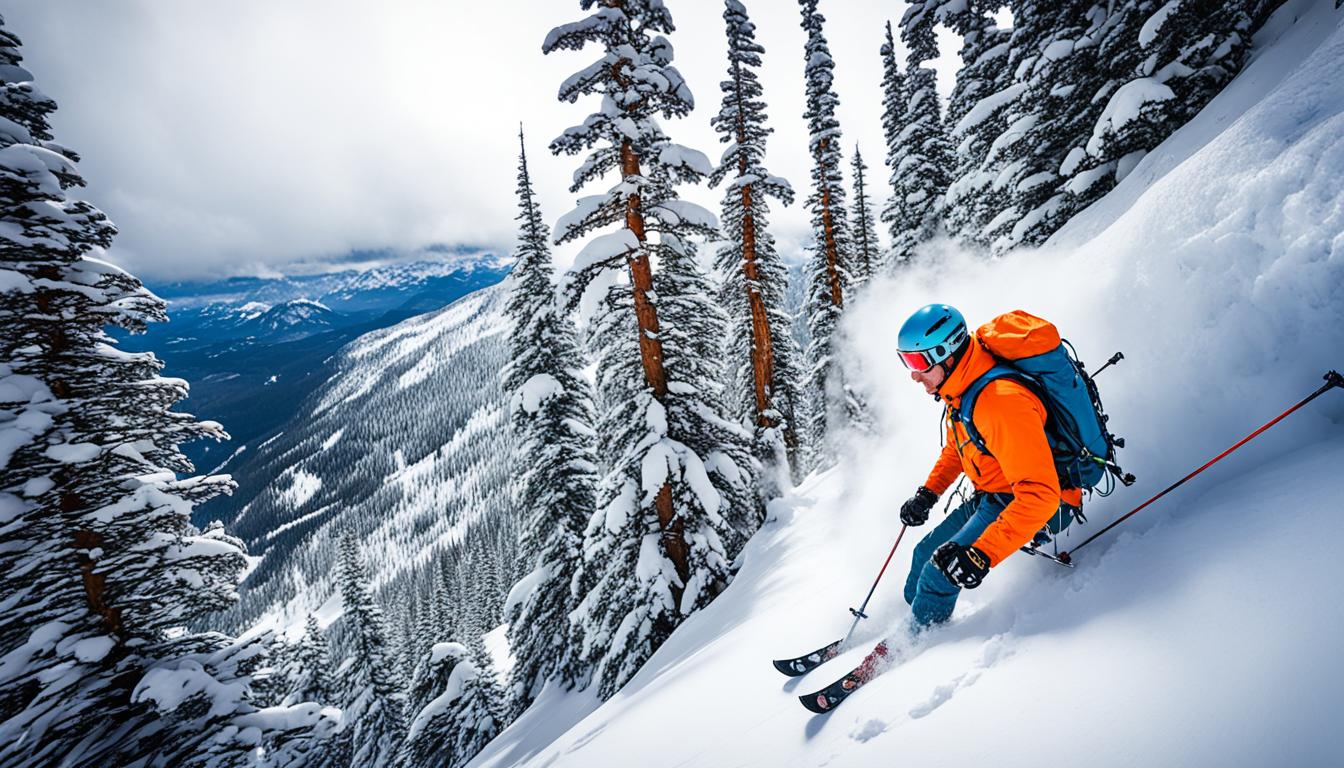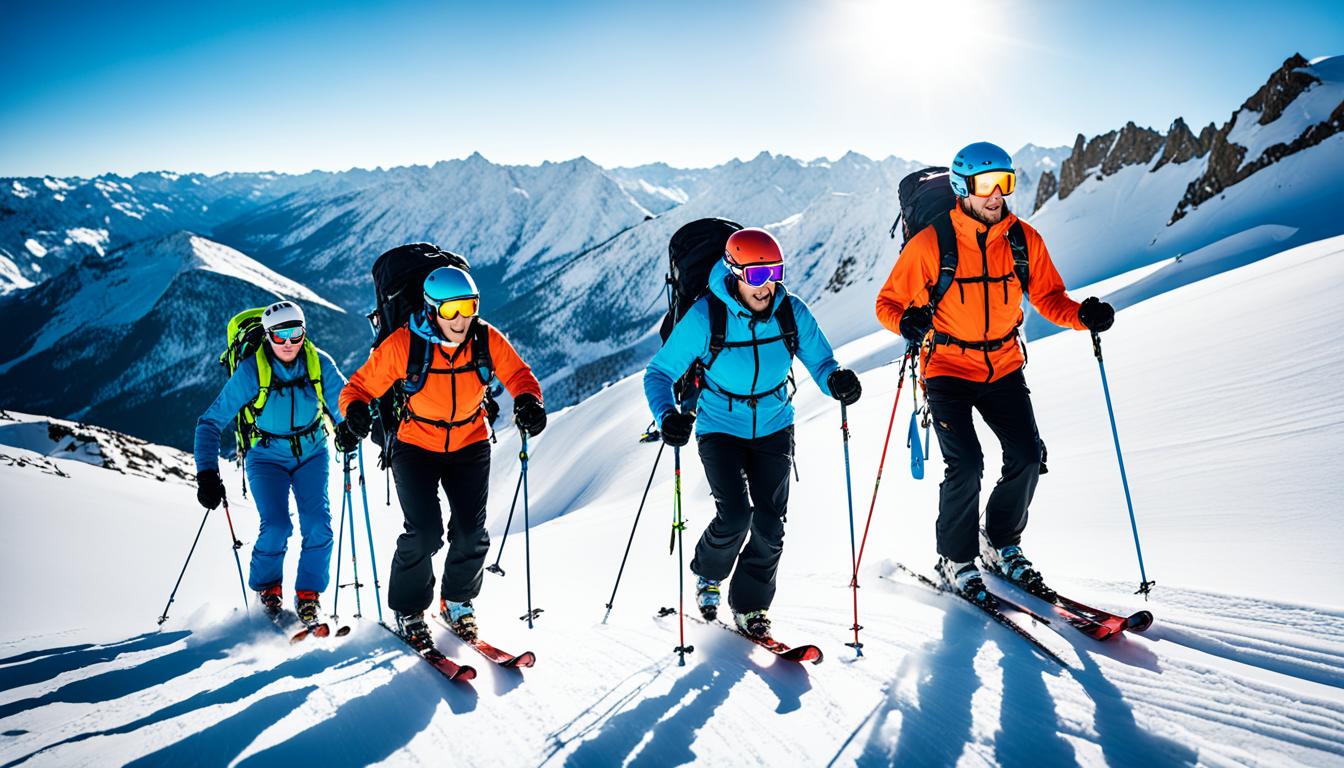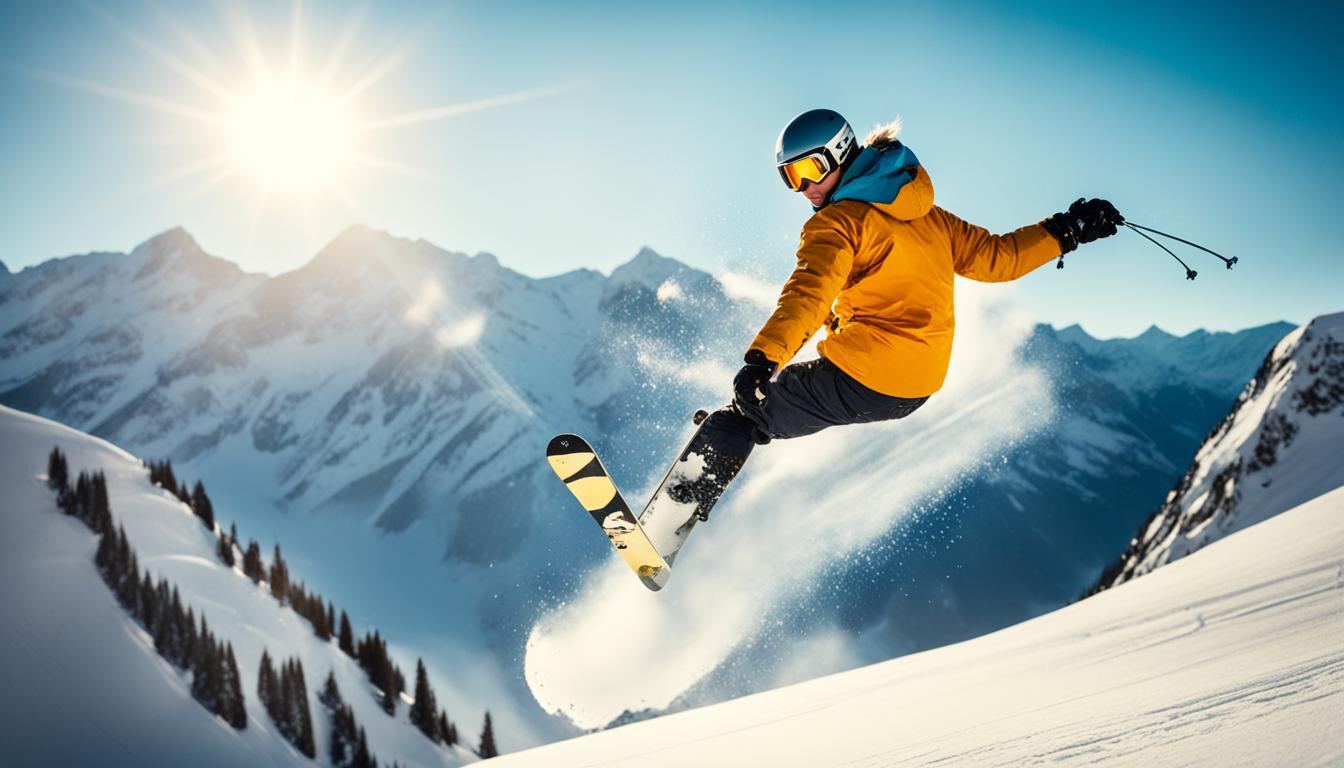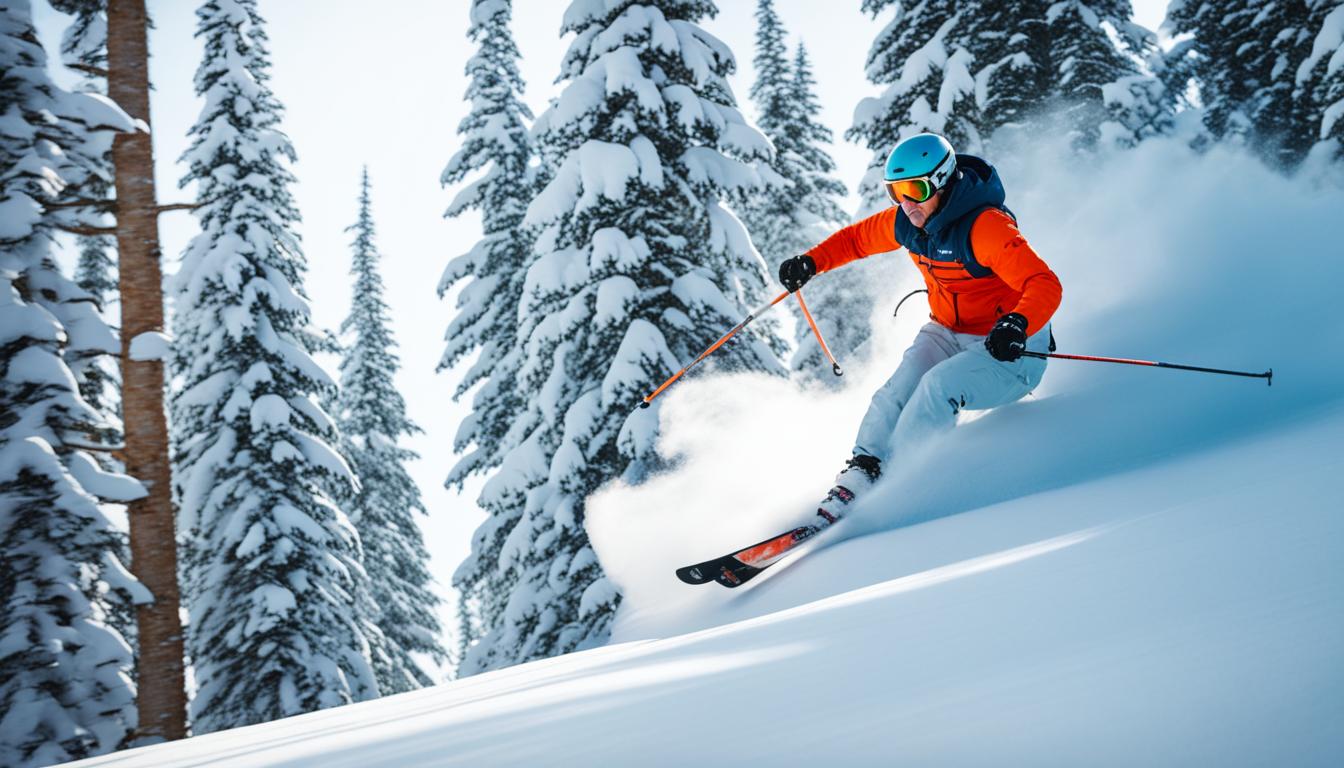Welcome to our guide on ski mountaineering in Colorado! If you’re seeking an exhilarating adventure in the heart of the Rocky Mountains, you’ve come to the right place. Colorado offers a myriad of opportunities for both beginners and experienced skiers looking to take their skills to new heights. In this article, we will delve into the best ski mountaineering routes, safety tips, and essential gear for a fantastic ski mountaineering experience in Colorado.
Key Takeaways:
- Colorado is a prime destination for ski mountaineering adventures.
- There are numerous ski mountaineering routes in Colorado, ranging from beginner-friendly to advanced.
- Safety is crucial in ski mountaineering, so ensure you have the necessary gear and skills to navigate the terrain.
- Essential gear for ski mountaineering in Colorado includes skis or a splitboard, climbing skins, safety equipment, and appropriate clothing.
- Consider taking a ski mountaineering course in Colorado to enhance your skills and knowledge for future adventures.
Now that you have an overview, let’s dive deeper into the world of ski mountaineering in Colorado. Strap on your boots, grab your gear, and get ready for an unforgettable journey!
Ski Mountaineering Routes in Colorado
Colorado is home to numerous ski mountaineering routes that offer breathtaking views and challenging terrain. Whether you’re a seasoned skier or a beginner looking to explore the backcountry, there are plenty of options to choose from. Here are some of the best ski mountaineering spots in Colorado:
Maroon Bells Traverse
The Maroon Bells Traverse near Aspen is considered one of the most iconic ski mountaineering routes in Colorado. With its stunning alpine scenery and technical challenges, this route attracts experienced mountaineers. The traverse involves climbing and descending several peaks, including North Maroon Peak and South Maroon Peak, each offering exhilarating skiing opportunities.
Grand Traverse
The Grand Traverse in Crested Butte is a popular ski mountaineering route that spans over 40 miles. This challenging adventure takes you from Crested Butte to Aspen, crossing rugged mountain terrain and traversing high alpine passes. The Grand Traverse requires excellent route-finding skills and expertise in backcountry skiing. It’s an incredible journey for those seeking an unforgettable ski mountaineering experience.
Capitol Peak Route
The Capitol Peak route near Snowmass is renowned for its technical difficulty and breathtaking views. This route requires advanced mountaineering skills, including ropework and exposed ridge traverses. The summit of Capitol Peak offers sweeping panoramas of the surrounding mountains, making it a rewarding destination for experienced ski mountaineers.
These ski mountaineering routes in Colorado offer not only thrilling descents but also an opportunity to immerse yourself in the stunning beauty of the Rocky Mountains. It’s crucial to research and plan your route beforehand, ensuring you have the necessary skills and experience to tackle the terrain. Consider hiring a guide or joining a ski mountaineering course to enhance your knowledge and safety on the slopes.
Ski Mountaineering Safety in Colorado
Safety is paramount in ski mountaineering, especially in the unpredictable backcountry terrain of Colorado. When venturing into the mountains, it’s essential to prioritize your well-being and take necessary precautions to mitigate risks. Here are some important safety measures to keep in mind:
- Check Avalanche Conditions: Before heading out, always check the latest avalanche conditions and forecasts. Use reputable sources such as the Colorado Avalanche Information Center (CAIC) to stay informed about the current snowpack stability and potential hazards.
- Carry Safety Gear: Make sure to bring essential safety gear, including an avalanche beacon, probe, and shovel. These tools are vital for rescuing yourself or others in the event of an avalanche. Keep them easily accessible and practice using them beforehand for efficiency.
- Master Avalanche Safety Skills: Having the skills to recognize, navigate, and manage avalanche terrain is crucial. Consider taking a ski mountaineering course or hiring a guide who can teach you proper techniques for route selection, snowpack evaluation, and safe travel in the backcountry.
- Travel with Partners: Ski mountaineering is best enjoyed with others. Traveling in a group increases your safety by providing additional support, knowledge, and resources. It’s important to establish clear communication, stay within visual and vocal range, and be prepared to assist each other in case of emergencies.
- Be Prepared for Weather Conditions: Weather conditions in the mountains can change rapidly. Dress in layers and carry extra clothing to adapt to changing temperatures. Stay updated on weather forecasts, and always err on the side of caution by turning back or seeking shelter if conditions worsen.
Remember, safety is a shared responsibility. By practicing proper safety measures, you can minimize risks and ensure a rewarding and enjoyable ski mountaineering experience in the beautiful mountains of Colorado.
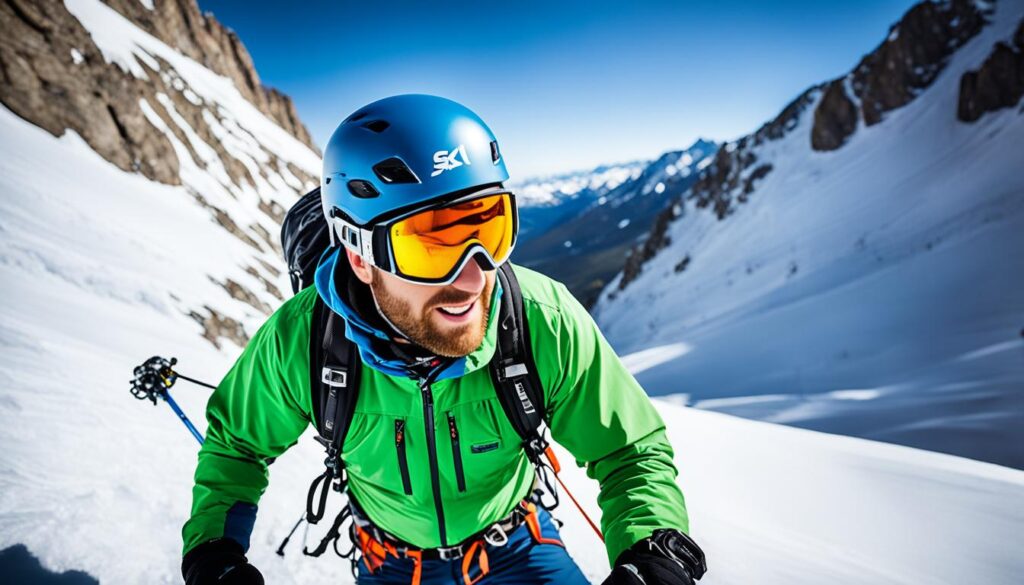
Essential Gear for Ski Mountaineering in Colorado
When embarking on a ski mountaineering adventure in Colorado, having the right gear is essential.
Here is a list of must-have items for a successful and safe ski mountaineering experience:
- Alpine touring skis or a splitboard: These specialized skis or boards are designed for both uphill climbs and downhill skiing, allowing you to navigate diverse mountain terrains.
- Climbing skins: These adhesive strips attach to the bottom of your skis or splitboard, providing traction and grip while ascending steep slopes.
- Goggles: Protect your eyes from the sun, wind, and snow glare with quality goggles that offer clear vision and UV protection.
- Helmet: Ensure your safety by wearing a helmet designed for skiing and mountaineering, reducing the risk of head injuries.
- Hard or softshell pants: Choose pants that provide both insulation and breathability, keeping you warm and dry in changing weather conditions.
- Synthetic or merino wool base layers: These moisture-wicking and insulating layers are crucial for regulating body temperature and keeping you comfortable throughout your adventure.
- Softshell or insulated jacket: A versatile jacket that offers protection from wind, snow, and cold temperatures is essential for staying warm and dry during your mountaineering expedition.
- Gloves: Invest in high-quality gloves that provide both warmth and dexterity, allowing you to maintain a good grip on your equipment while protecting your hands from the elements.
- Hat or visor: Keep your head warm and shielded from the sun with a hat or visor that fits comfortably under your helmet.
- Sunglasses: Protect your eyes from the sun’s harmful UV rays and snow glare with sunglasses designed for outdoor activities.
- Neck gaiter or buff: Keep your neck and face protected from wind, cold, and snow by wearing a versatile neck gaiter or buff.
- Backpack: Choose a backpack with a capacity of at least 30L to accommodate all your gear and essentials. Look for a pack with ski or snowboard carry options for convenience.
- Safety gear: Carry avalanche safety gear, including an avalanche beacon (transceiver), probe, and shovel, to ensure you are prepared for any potential avalanche risks.
If you don’t have your own gear, rental options are available at various outdoor equipment stores and ski resorts in Colorado.
Your gear plays a crucial role in keeping you safe, comfortable, and prepared during your ski mountaineering adventure in Colorado. Invest in high-quality equipment and make sure everything fits properly before heading out to the mountains.
Testimonials from Experienced Skiers:
“Having the right gear for ski mountaineering in Colorado is essential. The terrain can be unpredictable, and having reliable equipment is crucial for a safe and enjoyable experience.”
“Investing in quality gear is a must when ski mountaineering in Colorado. It makes a significant difference in comfort, performance, and overall enjoyment.”
Conclusion
Ski mountaineering in Colorado offers adventure, beauty, and excitement for outdoor enthusiasts. Whether you’re a beginner looking for an introduction to the sport or an experienced skier wanting to explore new routes, Colorado has it all. With proper planning, safety precautions, and the right gear, you can have an unforgettable ski mountaineering experience in the stunning Rocky Mountains.
Consider taking a ski mountaineering course in Colorado to enhance your skills and knowledge for future adventures. These courses provide expert guidance and instruction to help you navigate challenging terrains, understand avalanche safety, and hone your mountaineering techniques. Learning from experienced instructors will give you the confidence and expertise needed to tackle the diverse ski mountaineering routes in Colorado.
Start planning your ski mountaineering journey today and embrace the thrill of conquering Colorado’s peaks. From the breathtaking Maroon Bells Traverse to the challenging Capitol Peak route, there’s something for every level of ski mountaineer. Immerse yourself in the beauty of the Rocky Mountains, challenge your limits, and create memories that will last a lifetime.
FAQ
What is ski mountaineering?
Ski mountaineering is a sport that combines skiing and mountaineering, allowing enthusiasts to explore and ascend mountains on skis. It often involves steep and challenging terrain, requiring technical skills such as ropework and climbing.
Is ski mountaineering suitable for beginners?
Ski mountaineering can be suitable for beginners, but it is important to have basic skiing skills and physical fitness. Taking a ski mountaineering course or hiring a guide is recommended for beginners to learn the necessary skills and safety precautions.
Where can I find the best ski mountaineering spots in Colorado?
Colorado offers a multitude of ski mountaineering routes with breathtaking views and challenging terrain. Some popular spots include the Maroon Bells Traverse near Aspen, the Grand Traverse in Crested Butte, and the Capitol Peak route near Snowmass.
How can I ensure safety while ski mountaineering in Colorado?
Safety is crucial in ski mountaineering, especially in the unpredictable backcountry terrain of Colorado. Before your adventure, check avalanche conditions, carry essential safety gear, and have the skills to navigate steep slopes and manage avalanche terrain. Consider taking a ski mountaineering course or hiring a guide to enhance your knowledge and experience.
What gear do I need for ski mountaineering in Colorado?
Essential gear for ski mountaineering in Colorado includes alpine touring skis or a splitboard, climbing skins, goggles, helmet, hard or softshell pants, synthetic or merino wool base layers, a softshell or insulated jacket, gloves, a hat or visor, sunglasses, and a neck gaiter or buff. It is also important to carry a backpack with a capacity of at least 30L and essential safety gear like an avalanche beacon, probe, and shovel.
Where can I take ski mountaineering courses in Colorado?
There are various options for ski mountaineering courses in Colorado. Some reputable organizations and guide services that offer courses include Colorado Mountain School, American Alpine Institute, and Colorado Mountain Club. These courses can provide valuable knowledge and skills for your ski mountaineering adventures.

